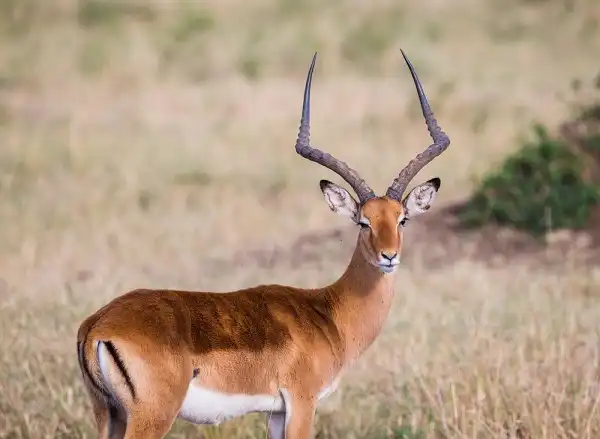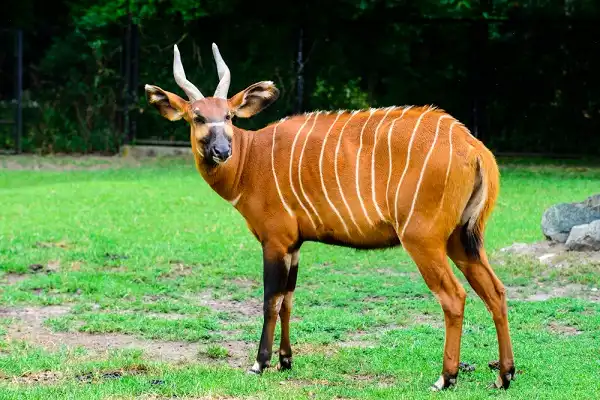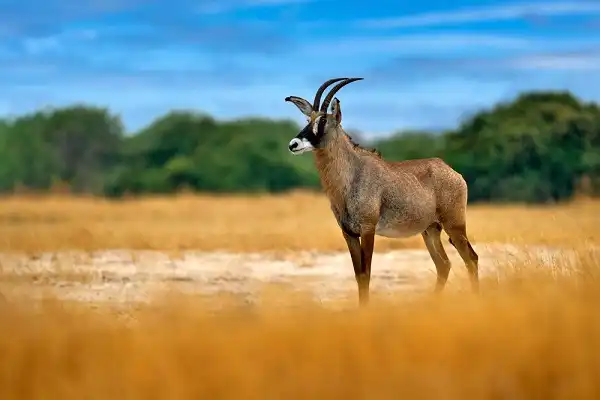The antelope is a species of hoofed mammal that have captivated humans for generations. With their elegant and graceful gait, captivating features, and adaptability to both high-altitude mountain ranges as well as dry deserts, these beautiful animals have managed to stand the test of time in spite of how difficult it can be to survive in those climates. What makes them even more fascinating is just how much we still don’t know about this incredible species, so let’s take some time today to learn more about the intriguing antelopes that roam our lands!

Antelope Description
Antelopes come in a variety of shapes and sizes. The average adult antelope stands between three and four feet tall, but some species can reach up to five feet. They have slender, graceful bodies and long legs that make them adept at running, jumping, and climbing in their natural habitats. Their coats range from sandy brown to black with white markings on the face and legs. Typically, the males will have horns or antlers that are used for territorial disputes and protection from predators. Perhaps the most impressive feature of antelopes is their incredible speed! This amazing agility gives them an edge over potential predators while allowing them to escape quickly if needed. All in all, antelopes are remarkable creatures that have been around since time immemorial due to their adaptability and resourcefulness. With their distinct physical features such as horns or antlers coupled with powerful strength and speed – not forgetting gracefulness – these animals have managed to stay alive despite our ever-changing environment!
Antelope Habitat
Antelopes can be found in many different habitats across the world. From tropical jungles and savannas to mountains, deserts, and even woodlands, these animals can thrive in a variety of locations. In Africa, antelopes are most commonly found in grassy plains and wooded areas such as the Serengeti Plain and Kalahari Desert. They can also be spotted in scrubland and shrubland environments like the Sahel region of northern Africa. In Asia, they inhabit rugged mountain ranges such as the Hindu Kush, Himalayas, and Pamir Mountains where they have adapted to extreme temperatures and altitudes. The Arabian Peninsula is another place where you can find antelopes living in the deserts as well as oases located near water sources. In Europe, small populations of antelope species have been seen near the Caucasus Mountains which span from Russia to Turkey. While not as numerous as their African counterparts, these animals still manage to survive due to their ability to adapt quickly to changing environments.
Antelope Diet
The antelope diet is highly varied and depends on what is available in their given habitat. They generally eat grasses, herbs, leaves, twigs, bark, fruit, and flowers. In addition to grazing, they also may scavenge for insects to supplement their diet. This can be especially useful during harsher climates where the food supply is limited. During times of drought or famine, antelopes may migrate in order to find better sources of food or water. For instance, some herds have been observed moving hundreds of miles from Africa’s grasslands to the rainforests during dry periods in search of sustenance. These large migrations often involve multiple species of antelopes traveling together in order to make it easier for them all to find nourishment and avoid predators.
To survive in these harsh environments, antelopes have adapted to eat a wide variety of vegetation which ranges from shrubs and trees to succulent plants and even cacti! They also consume various parts of plants such as roots and tubers which provide them with additional nutrients that are not found elsewhere. In addition to grazing, some species will also feed on insects such as termites and beetles when available. This helps supplement their diets with valuable protein sources which boosts their overall health and ability to thrive.

Antelope Size
Antelopes come in a range of sizes depending on the species, with the average adult standing between 3 and 4 feet tall. However, some species can reach up to 5 feet or even larger! Males typically have horns or antlers which are used for both defense and dominance among herds. These can range from short spikes to large curved horns that span several inches. In terms of weight, adult antelopes range from 90-220 pounds depending on the species and male/female distinctions. Females tend to be slightly smaller than males due to their lack of horns or antlers. This lighter frame does not detract from their strength however; they are incredibly strong animals that are capable of carrying much more weight than you would expect given their size!
Antelope Lifespan
The lifespan of antelopes can vary significantly depending on the species and its natural environment. On average, they live between 5 and 20 years in the wild, although some may live longer if they are able to find adequate habitat and resources. Generally speaking, males tend to have shorter lifespans than females due to their aggressive nature and tendency to engage in more territorial fights with other males. In captivity, antelopes can live much longer with some living up to 30 years or more. This is because they are able to access food sources more easily as well as receive necessary medical care when needed. Various factors can influence an antelope’s lifespan however, including disease, predation, drought or famine, and human disturbance. For instance, diseases such as bovine tuberculosis have been known to affect lifespan as they weaken animals’ immune systems making them more vulnerable to attack or illness.
Antelope Behavior
Antelopes exhibit a wide range of behaviors in their natural environment. Commonly seen behavior includes grazing, running, and resting in large herds. Herds often consist of several individuals ranging from a few to several dozen depending on the species. This allows them to better protect themselves from potential predators as well as disperse food resources throughout the group. When threatened by predators such as lions or cheetahs, antelopes will either use their speed and agility to escape or form a defensive circle around the younger members of the herd. The young are usually protected in the center while the adults form an outer ring with their horns pointed outward, providing extra protection against any potential attacks.
In addition to protection, antelopes also use their horns for displays of dominance among other males within the same herd. These displays can range from jostling with one another or even head-butting until one animal submits. Horns may also be used for courtship rituals between males and females, where males will curl their horns to try and impress potential mates. Aside from their physical defense mechanisms, antelopes also make use of vocalizations such as barks and bleats when communicating with each other or warning others of danger. They can also communicate through scent marking; animals will urinate on grasses to mark their territory and attract potential mates.

Antelope Speed
Antelopes are known for their incredible speed and agility, allowing them to escape potential predators or travel long distances when food sources become scarce. On average, antelopes can run up to 30 miles per hour but some species can reach speeds of fifty miles per hour or more. This impressive speed enables them to outrun many of their predators which can include lions, cheetahs, and hyenas. Not only do they have great running speed but they also possess superlative jumping abilities that are unmatched by most animals. Antelope can leap up to 12 feet in a single bound, making it difficult for predators to capture them even when they get close.
This combined with their agility makes them one of the most successful animals in the wild! In addition to running and leaping, antelopes also possess remarkable stamina which allows them to cover large distances in search of food or better habitats. Studies have shown that some species can maintain a steady trot for as long as fifteen minutes non-stop without tiring out! Furthermore, the fact that antelope can so easily adapt to different terrains makes it possible for them to cover vast areas in search of food and water resources quickly and efficiently.
Antelope Predators
Antelopes have numerous predators that can vary depending on the species and their natural environment. Predators can include large cats such as lions, tigers, leopards, and cheetahs as well as hyenas, wolves, and wild dogs. Birds of prey such as eagles and hawks may also be a threat to antelopes when they are young or vulnerable due to their smaller size. However, it is important to note that not all predators pose a significant threat to antelopes; in fact, most will only kill when desperate or surprise them during their period of vulnerability such as during mating season or while they are asleep. As a result, antelopes have evolved various defense mechanisms over time including speed and agility when running away from danger as well as the ability to form protective herds to ward off predators.
Antelope Hunting
Antelope hunting is a popular activity among some hunters, who pursue the animals for their meat, hides, horns, and other body parts. In addition to being sought after by poachers, antelopes are also hunted legally in many countries. However, antelope hunting is not an easy task; it requires skill and knowledge of the animal’s behavior as well as patience and determination. It is important to remember that when hunting antelopes, one must always be aware of their superior agility and speed which can help them escape from predators. Therefore, hunters must take extra caution when approaching these animals or setting up traps to ensure that they do not startle them. It is also important to note that when hunting antelopes in open areas, wind direction should be taken into account so that the hunter does not scare away his prey with his scent. In addition to this, hunters should be aware of the signs that indicate the presence of an antelope such as tracks or fresh droppings. These signs can help the hunter determine which direction the animal has moved off in and what type of terrain he will need to traverse if he wants to successfully hunt it down.

Conclusion
Antelopes are truly amazing animals that have been able to thrive in the wild due to their incredible speed and agility, remarkable stamina, and strong defense mechanisms against predators. Not only do they possess these physical characteristics but they also demonstrate keen survival instincts which allow them to outsmart many of their enemies. Furthermore, even though antelope hunting is a popular activity among some hunters, it is important for individuals to remain mindful of the animal’s capabilities when pursuing them or setting up traps. This ensures not only a successful hunt but also helps protect antelopes from becoming endangered species due to overhunting.
Frequently Asked Question


